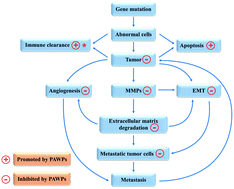Peptidomic analysis of pilose antler and its inhibitory effect on triple-negative breast cancer at multiple sites
Abstract
Pilose antler (PA) is a traditional Chinese functional food that has been reported to inhibit breast cancer; however, the specific substances that exert this effect and the underlying mechanisms remain unknown. This study aims to identify the specific proteins in PA water-soluble polypeptides (PAWPs) that are involved in cancer inhibition and determine the effects of PAWPs on triple-negative breast cancer in mice. In this study, peptidomic analysis of 105 varieties of polypeptides from PAWPs was carried out using LC-MS, 22 of which had functions that could potentially suppress tumors, including endopeptidase inhibitors, metal ion-binding proteins, angiogenesis inhibitors, intercellular adhesion proteins, and extracellular matrix repair proteins. Furthermore, we showed that intragastric administration of PAWPs into mice inhibited the growth and metastasis of triple-negative 4T1 breast tumors. PAWPs activated the expression of cleaved-caspase3 and increased tumor apoptosis, resulting in the reduction of platelet-endothelial cell adhesion molecule (PECAM-1/CD31) expression and the number of blood vessels, as well as the inhibition of matrix metalloproteinase (MMP) 2 and 9, increasing the ratio of Cadherin-1 (CDH1)/Cadherin-2 (CDH2) and inhibiting epithelial–mesenchymal transition (EMT) in these tumors. Therefore, PAWPs inhibit the progression and metastasis of triple-negative 4T1 breast cancer at multiple key sites in mice and contain various tumor suppressor proteins that are potentially involved in these processes.

- This article is part of the themed collection: Food & Function Recent HOT articles


 Please wait while we load your content...
Please wait while we load your content...